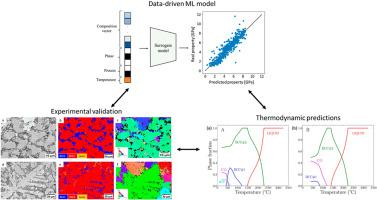Data-driven inverse design of MoNbTiVWZr refractory multicomponent alloys: Microstructure and mechanical properties
IF 7
2区 材料科学
Q1 MATERIALS SCIENCE, MULTIDISCIPLINARY
引用次数: 0
Abstract
Multicomponent refractory alloys have the potential to operate in high-temperature environments. Alloys with heterogeneous/composite microstructure exhibit an optimal combination of high strength and ductility. The present work generates designed compositions using high-throughput computational and machine-learning (ML) models based on elements Mo-Nb-Ti-V-W-Zr manufactured utilizing vacuum arc melting. The experimentally observed phases were consistent with CALPHAD and Scheil simulations. ML models were used to predict the room temperature mechanical properties of the alloy and were validated with experimental mechanical data obtained from the three-point bending and compression tests. This work collectively showcases a data-driven, inverse design methodology that can effectively identify new promising multicomponent refractory alloys.

数据驱动的 MoNbTiVWZr 难熔多组分合金反设计:微观结构和机械性能
多组分耐火合金具有在高温环境中工作的潜力。具有异质/复合微观结构的合金展现了高强度和延展性的最佳组合。本研究以利用真空电弧熔炼制造的 Mo-Nb-Ti-V-W-Zr 元素为基础,利用高通量计算和机器学习(ML)模型生成设计成分。实验观察到的相位与 CALPHAD 和 Scheil 模拟一致。ML 模型用于预测合金的室温力学性能,并与三点弯曲和压缩试验获得的实验力学数据进行了验证。这项工作共同展示了一种数据驱动的逆向设计方法,该方法可以有效地识别新的有前途的多组分耐火合金。
本文章由计算机程序翻译,如有差异,请以英文原文为准。
求助全文
约1分钟内获得全文
求助全文
来源期刊

Materials Science and Engineering: A
工程技术-材料科学:综合
CiteScore
11.50
自引率
15.60%
发文量
1811
审稿时长
31 days
期刊介绍:
Materials Science and Engineering A provides an international medium for the publication of theoretical and experimental studies related to the load-bearing capacity of materials as influenced by their basic properties, processing history, microstructure and operating environment. Appropriate submissions to Materials Science and Engineering A should include scientific and/or engineering factors which affect the microstructure - strength relationships of materials and report the changes to mechanical behavior.
 求助内容:
求助内容: 应助结果提醒方式:
应助结果提醒方式:


